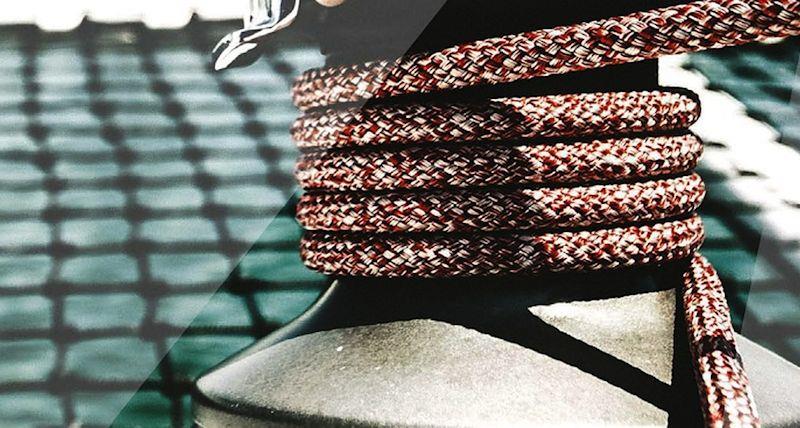
Robline Rope Cruising Ranges Explained
by Prinal Shah 5 Feb 2020 09:00 UTC

Robline Rope Cruising Ranges Explained © Robline
The success of Robline as an international rope brand is based on decades of expertise in manufacturing fibre ropes, the experience of professional sailors in the company, and the intensive collaboration with Olympic gold medallists and regatta-winning sailors.
In our previous blog we discussed the Robline dinghy lines and their recommended applications. In this post we will look at the different cruising ranges and how you might choose between them, to suit your needs.
When comparing products, we always like to start with the data and see where that takes us. Find below the basic data for Robline's three core cruising ranges: Neptun, Orion and Sirius.
| Range | Core | Cover | Use | Weight (g/m) | MBL (daN) | Dia. Range (mm) | Price (£/m) Ex VAT |
|---|
| Neptun 500 | Polyester | Polyester 16 | Sheet | 62 | 1800 | 6. 8. 10. 12. 14 | 2.24 |
| Orion 300 | Polyester | Polyester 16 | Crossover | 70 | 2000 | 4. 5. 6. 8. 10. 12. 14 | 2.48 |
| Orlon 500 | Polyester | Polyester 16 | Crossover | 70 | 2000 | 2. 3. 4. 5. 6. 8. 10. 12 | 2.66 |
| Sirius 300 | Polyester | Polyester 24 | Crossover | 71 | 2800 | 4. 5. 6. 8. 10. 12. 14 | 2.69 |
| Sirius 500 | Polyester | Polyester 32 | Crossover | 71 | 2800 | 4. 5. 6. 8. 10. 12. 14 | 2.81 |
| Sirius Grip | Polyester | Soft Polyester | Sheet | 71 | 2300 | 8. 10. 12 | 2.95 |
| Sirius 1000 | Dyneema XLF | Polyester 32 | Crossover | 67 | 2400 | 6. 8. 10. 12 | 3.55 |
| Sirius XTS | Dyneema XLF | Polyester
| Crossover | 76 | 2900 | 6. 8. 10. 12 | 4.73 |
Key variables
Strength
The Neptun 500 is the baseline, budget-orientated, cruising line from Robline. Relative to the other options, the Neptun has a lower break strength. This lower strength means that for the same application, this line is working at a higher percentage of its Maximum Breaking Load (MBL).
Let's take a genoa sheet load of 750kg as an example: The Neptun 500 line (with an MBL of 1800kg) will be working at approx. 42% of its MBL. However, in the same application, the Sirius 500 (with an MBL of 2800kg) will be working at just 26% of its MBL. The greater the working load, relative to MBL, the harder the line is working and the faster the line will fatigue.
Line strength (MBL) is an important element of rope choice and it really helps if you know the actual loads on your boat. The Neptun 500 is a perfectly good line and in a low load application is just as good as any of the other Robline cruising lines - you just need to understand that the lower break strength impacts relative longevity.
Braided cover
The other differentiator between the lines is the number of carriers (16, 24 or 32) used to construct the braided cover. In simple terms, the greater the number of carriers, the tighter the braid which means it is both stiffer and more durable against chafe / abrasion. Having said that, for a control line, or a sheet on a small boat, which is constantly being adjusted, the softer feel of a 16-carrier braid is a distinct advantage.
Material choice
Finally, the core and cover material is the other key variable. Polyester has been around since the 1950's and is still widely used in sailing ropes due to its excellent strength and abrasion resistance. However since the 1990's, the more expensive Dyneema® has been gradually taking over the performance end of the market due to its very high strength to weight ratio, low moisture absorption and amazing durability.
Range Summary
Neptun 500 - Soft feel, low load, relatively low use, budget orientated cruising line for sheets and control lines
Orion 300 / 500 - A large size range and a core element of Robline's cruising range. The only difference between the Orion 300 and 500 is the more modern colour options of the 500 range. Ideal for sheets and control lines.
Sirius 300 / 500 - A step up in terms of strength, stiffness and durability, from the Orion, due to the 24 / 32 carrier braided covers. Ideal for larger sheets and halyards, where stiffness is more important.
Sirius Grip - a specialist product designed specifically for its soft feel which is ideal for sheets on smaller boats which are constantly adjusted.
Sirius 1000 - The Dyneema® XLF core is a step up in terms of strength to weight and aimed at performance cruisers
Sirius XTS - The Technora® / UHMWPE (Ultra-High-Molecular-Weight Polyethylene) cover is specifically designed for use in halyard clutches to improve grip (Technora®) and abrasion resistance (UHMWPE).
Conclusion
For smaller boats and low use applications, the Neptun 500 is a good quality line. The core of the Robline cruising range would be Orion300/500, for sheets and control lines, but it might be worth paying the modest price increase to get the improved stiffness of the Sirius 300/500 for Halyards. As boat size and loads increase, you would see more durability switching to Sirius 500 / 1000 for sheets and transitioning to the specialist Sirius XTS for halyards.
If you have any questions or would like help with your running rigging selection, click here, or alternatively you may contact upffront.com using this contact form.